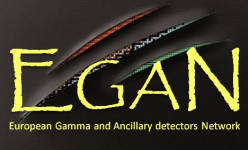Matthias Hackstein
(Institut für Kernphysik, Universität zu Köln)
28/06/2011, 17:05
In light, even-mass Hg isotopes, a weakly deformed oblate ground state band is found to coexist with a more deformed prolate band. To investigate the nuclear structure in more detail a recoil-distance Dopplershift (RDDS) experiment has been performed to determine absolute transition strengths in 186Hg. These transition strengths provide information on the level mixing amplitudes of the two...
Eiji UEGAKI
(Dept. of Mech. Engineering, Akita Univ., Japan)
28/06/2011, 17:15
High-spin resonances well above the Coulomb barrier in 24Mg+24Mg and 28Si+28Si systems exhibit many narrow and prominent peaks correlated among the elastic and inelastic channels, which suggest rather long-lived compound systems and offer intriguing subjects in nuclear physics. Angular correlation measurements for 28Si+28Si made with 4π gamma detectors have provided crucially important...
Suzana Szilner
(Ruder Boskovic Institute)
28/06/2011, 17:25
Multinucleon transfer reactions have been investigated in 40Ar+208Pb via particle-gamma coincidences with the Prisma+Clara set-up. New states have been identified and the strongly populated states have been discussed and compared with the sd-pf shell model calculations. In odd Ar isotopes, we identified a significant population of 11/2- states, reached via neutron transfer. Their structure ...
Dennis Mücher
(Physics Department E12, TU Munich)
28/06/2011, 17:35
T-REX is an ancillary detector device for the MINIBALL setup at REX-ISOLDE, CERN. It consists of eight position sensitive silicon barrel detectors as well as a DSSSD CD-detector. This allows to cover a large range of scattering angles, what gives the possibility to determine spins and relative spectroscopic factors after transfer reactions using RIBs. We will introduce the T-REX setup and...
Liam P. Gaffney
(University of Liverpool)
28/06/2011, 17:55
There is considerable theoretical and experimental evidence that atomic nuclei can assume reflection asymmetric shapes that arise from the octupole degree of freedom. From a microscopic point of view, the wave functions of low-lying 3- octupole excitations must contain components which include the intruding unique parity state ( _l_ , _j_ ). Because of the nature of the octupole-octupole...
Natalia Cieplicka
(Institute of Nuclear Physics, Polish Academy of Sciences, Krakow)
28/06/2011, 18:05
The 206Bi nucleus is a one-proton-particle, three-neutron-hole system with respect to the doubly magic 208Pb core. Its low-energy structure arises from 1p-3h couplings involving 1h9/2, 2f7/2, and 1i13/2 proton particles, and 3p1/2, 2f5/2, 3p3/2 and 1i13/2 neutron holes. The 206Bi ground state, with spin-parity Jπ=6+, is of πh9/2νf5/2-1 character, with the isomeric (T1/2=7.7 μs) Jπ=4+ member of...
Tayfun Huyuk
(IFIC (CSIC - Universidad de Valencia))
28/06/2011, 18:15
This work includes the simulations performed in order to design a new neutron detector array NEDA (NEutron Detector Array). NEDA will address the physics of neutron-rich as well as neutron deficient nuclei, mainly in conjunction with gamma-ray detectors arrays like AGATA, EXOGAM2 and PARIS.
The geometry of NEDA is being optimized using Geant4 and ROOT analysis codes. Different size of the...
Akis Pipidis
(INFN, Laboratori Nazionali di Legnaro, Legnaro (Padova), Italy)
28/06/2011, 18:25
Shell Structure Far from Stability
In nuclear-structure physics, especially while exploring unknown regions of the chart of nuclides, the experimenter needs to carefully address the identification of the products from nuclear reactions. The reaction channel selectivity can
be achieved through the detection of all, or at least as many as possible, of the emitted light particles (mainly neutrons, protons, and/or α particles)....
Sezgin AYDIN
(Department of Physics, University of Aksaray, Aksaray, Turkey)
28/06/2011, 18:35
In the present work, structure of the 36Cl nucleus has been studied using Compton-suppressed GASP array. Medium-spin states in the 36Cl nucleus have been populated in the 24Mg(14N,2p) fusion-evaporation reaction at Elab = 31 MeV. Fifteen new excited levels decaying through more than 40 gamma transitions have been assigned to this nucleus. The branching ratios and angular distributions have...

